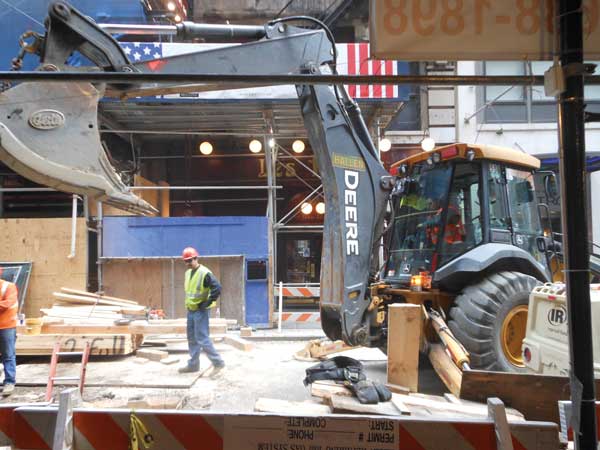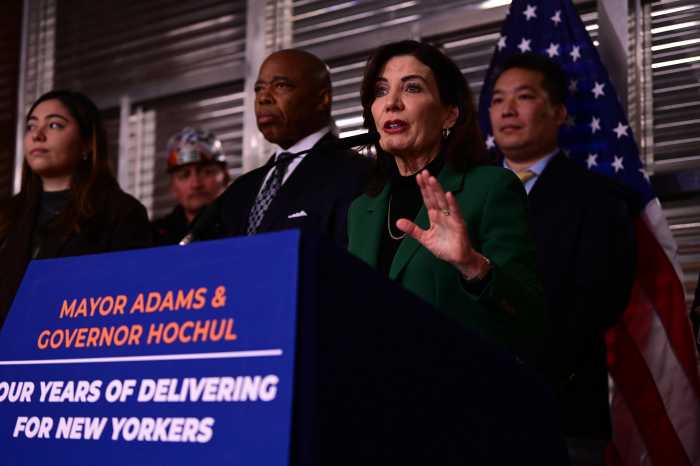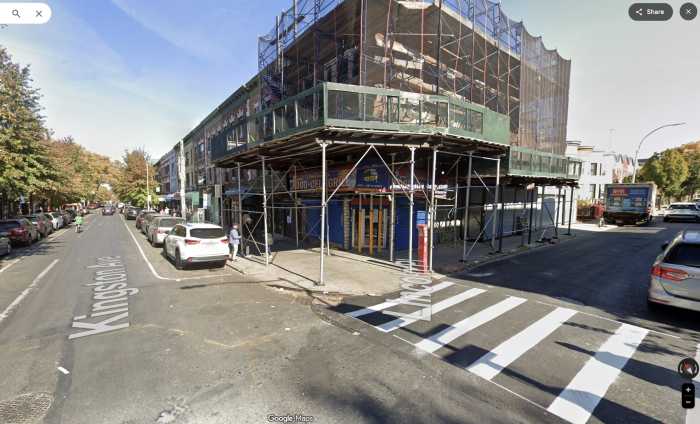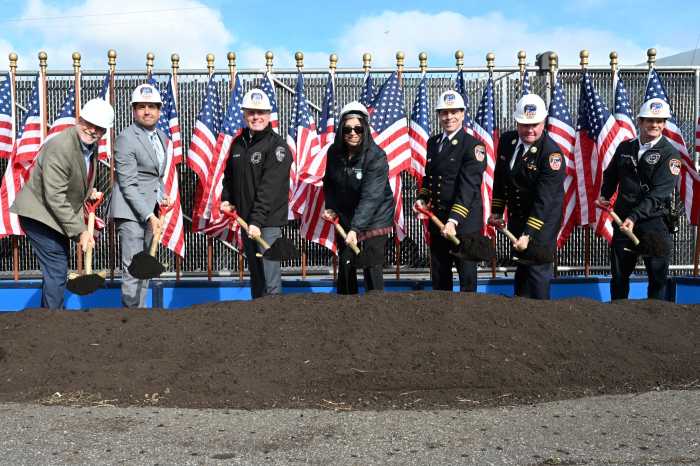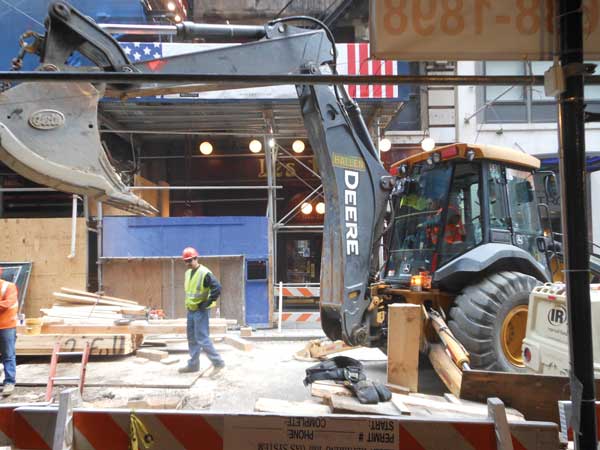 [/media-credit]
[/media-credit]
Close to 100 Financial District residents and business owners that have been dealing with five ongoing construction projects in their neighborhood, attended a hearing last Tues., March 6. The meeting, organized by Community Board 1, with the help of NYS Assembly Speaker Sheldon Silver’s office and the Lower Manhattan Contruction Command Center, gave residents the opportunity to question city officials and private developers about how they plan to address quality of life concerns in relation to the construction.
The disturbances are principally coming from 180-182 Broadway, where commercial developer SL Green Realty Corp. is erecting a 23-story dormitory for Pace University. Another major concern is the excavation along John Street, which Con Edison is ripping up to replace leaky cast iron gas mains stretching below ground from Nassau Street to Broadway. The meeting is the culmination of months of complaints by individual community members, according to 12 John St. resident Barbara Minsky, who helped spread the word about the meeting.
“We want nights and weekends quiet, we want no after-hour work variances, we want to have dinner without a jackhammer vibrating our tables,” said Minsky. “To me, this whole thing is 9/11 part two.”
Avi Fuzailov, owner of Daniela Hair Salon at 28 John St., fears he might have to shutter his 20-year-old business this spring if conditions don’t immediately improve.
“We have bigtime problems – before the construction started, this was the most favorite street for the people to cross,” said Fuzailov. “Now, because of construction, they’re switching to other streets.”
David Colman, who lives at 65 Nassau St., complained about the sheer number of projects happening in close proximity of one another.
“I want to know why there is no overseer that could have said, ‘Hey, wait a minute, we have five 747s landing on the same runway in five minutes,’” Colman said. “That is what this is like. It’s insane.”
Ed Kamerer, general manager of energy services at Con Edison, said the utilities work being done below John Street is urgent, and that Con Edison obtains after-hour permits in order to shorten the overall duration of the assignment. “This project, had we not had the longer hours during the day, would have taken six months to do,” said Kamerer.
Con Edison expects to finish all excavation work on John Street by Monday, March 19, after which the street will be closed “in expeditious fashion,” according to Kamerer.
Kamerer added, “We’re certainly not perfect, and I’m not standing up here and saying we are.”
In the meantime, Con Edison should be required to fasten the street plates so they don’t bother nearby residents by shaking as cars drive over them, according to Betty Cohen, a spokesperson for Century 21 department store, located a few blocks away.
“If they’re level and secured on the four corners, they don’t bounce up and down at night, and people will be able to sleep,” said Cohen.
Responding to Cohen, Kamerer said that keeping the plates from jiggling is actually difficult, but that he would order his contractors figure out a way to secure them so that they wouldn’t continue to rattle.
“I can have this resolved tomorrow,” said Kamerer.
The following night, Con Edison received a summons from the city Department of Environmental Protection for loose plates, according to sources, and just last weekend, residents were kept up past 1 a.m. from emergency street work.
In an e-mail sent to stakeholders on Monday, March 12, Kamerer’s colleague, Patricia Richardi, apologized for the weekend work, which was attributed to connecting electrical cables to the Fulton Street Transit Center, an M.T.A. project. “We will make every effort to limit this work to daytime hours moving forward, and to… keep everyone involved apprised of the work,” she said.
Minsky expressed dissatisfaction with Richardi’s comments in a reply e-mail. “We don’t want you to ‘make every effort,’” she said. “That’s corporate speak for, ‘I’m leaving wiggle room for there to be another three days of hell again.’”
Since the meeting, Tishman Construction, which is overseeing construction at 180-182 Broadway, has stopped deliveries and other preparation work between 6 and 7 a.m. and has removed table saws and other metal-beinding equipment from the site in attempt to mitigate noise.
The building will be fully enclosed by October, according to Brian Young, a vice president at Tishman Construction. Recently, workers have been granted a city work permit to receive deliveries from 6 a.m. to 7 a.m. and evening variances from 6 p.m. to midnight. Young justified the after-hour work by saying, “When the concrete is placed, sometimes the finishing operation runs later.”
Young said the project is still on schedule to be completed by the end of the year. “The hardest part right now is [building] the structure,” he said.
Other project representatives such as Judy Duffy from the M.T.A., which is constructing the Transit Hub, projected limited after-hour work moving forward. “We don’t anticipate any more weekend work other than underground components of some of the contracts that are still underway,” she said.
Michael Maisano, a project manager at DUC construction, said his workers will no longer be working overnight on the 21-story hotel, which is scheduled for completion in 2014 at 24 John St. “It’ll be a daytime operation — we have permits from 7 a.m. to 6 p.m.,” he said.
At the meeting, Geraldine Kelpin, the D.E.P.’s director of noise enforcement and policy, said the Department would work with the project representatives to come up with additional noise mitigation and dust suppression tactics for the sites. The Department is responsible for issuing violations to companies that violate noise and vibration regulations and that work at times they don’t have permits for.
“There are issues with noise – as it goes up, what you’re hearing is generally louder than what’s on the street, and that’s a very difficult situation to control,” said Kelpin.
Despite the built-in obstacles, Kelpin conceded that coordination of the various projects isn’t as effective as it could be.
“We have some issues with these after-hour variances,” said Kelpin, “because a lot of the projects are not coming in with their alternative plans to see whether they’re going to be actually making more noise than they should be.”



